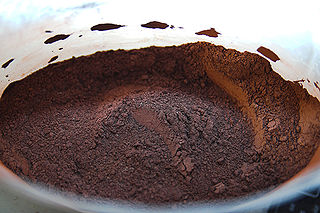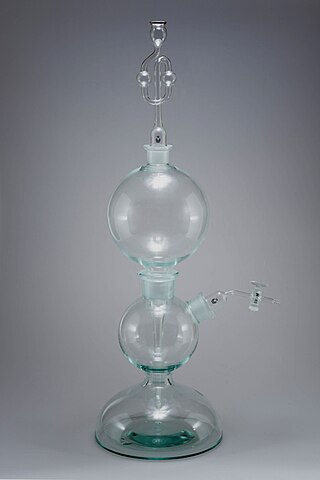Fart lighting, also known as pyroflatulence or flatus ignition, is the practice of igniting the gases produced by flatulence. The resulting flame is often of a blue hue hence the act being known colloquially as a "blue angel", "blue dart" or in Australia, a "blue flame". The fact that flatus is flammable and the actual combustion of it through this practice gives rise to much humorous derivation. Other colors of flame such as orange and yellow are possible depending on the mixture of gases formed in the colon.
In 1999, author Jim Dawson observed that fart lighting has been a novelty practice primarily among young men or college students for decades but is discouraged for its potential for causing harm. [1] Such experiments typically occur on camping trips and in same-sex group residences, such as tree-houses, dormitories, or fraternity houses. [2] With the advent of video sharing features online, hundreds of self-produced videos, both documentary as well as spoof, have been posted to sites such as YouTube. The people appearing in the videos are predominantly young teen males. [3] [4] In his book The Curse of the Self: Self-Awareness, Egotism, and the Quality of Human Life, author Mark Richard Leary explains how a great deal of unhappiness is due to people's inability to exert control over their thoughts and behavior and that "stupid stunts", including lighting flatulence, were a way to make an impression and be included in group bonding or hazing. [5]
There are many anecdotal accounts of flatus ignition, and the activity appears in popular culture. In his book Electric Don Quixote: The Definitive Story of Frank Zappa , author Neil Slaven quotes Zappa discussing "the manly art of fart-burning", and Zappa's lyrics for "Let's Make the Water Turn Black" include "Ronny helping Kenny helping burn his poots away". [6] Another Zappa book quotes his neighbor Kenny Williams saying that it demonstrates "compression, ignition, combustion and exhaust." [7]
There have been documented cases of flatulence during surgery being inadvertently ignited causing patient injury and the risk of death. [8] [9]
The composition of flatus varies dramatically among individuals. Flatulence produces a mixture of gases including methane, [10] which burns in oxygen forming water and carbon dioxide often producing a blue hue (ΔcH = −891 kJ/mol), [11] as:
Hydrogen sulfide is also flammable (ΔcH = −519 kJ/mol), [12] and burns to
Some of the gases that cause flatulence, such as methane and hydrogen, are produced by bacteria which live in symbiosis within the large intestines of humans and other mammals. The gases are created as a by-product of the bacteria's digestion of food into relatively simpler substances. [13] The oxygen and nitrogen component of flatus can be accounted for by aerophagy while the CO2 component results from the reaction of stomach acids (HCl) with alkaline pancreatic bile (NaHCO3).
The odor associated with flatus is due to hydrogen sulfide, skatole, indole, volatile amines, and short-chain fatty acids also produced by the bacteria. These substances are detectable by olfactory neurons in concentrations as low as 10 parts per billion, hydrogen sulfide being the most detectable. [14]

In organic chemistry, an alkane, or paraffin, is an acyclic saturated hydrocarbon. In other words, an alkane consists of hydrogen and carbon atoms arranged in a tree structure in which all the carbon–carbon bonds are single. Alkanes have the general chemical formula CnH2n+2. The alkanes range in complexity from the simplest case of methane, where n = 1, to arbitrarily large and complex molecules, like pentacontane or 6-ethyl-2-methyl-5-(1-methylethyl) octane, an isomer of tetradecane.

A Bunsen burner, named after Robert Bunsen, is a kind of ambient air gas burner used as laboratory equipment; it produces a single open gas flame, and is used for heating, sterilization, and combustion.
Flatulence is the expulsion of gas from the intestines via the anus, commonly referred to as farting. "Flatus" is the medical word for gas generated in the stomach or bowels. A proportion of intestinal gas may be swallowed environmental air, and hence flatus is not entirely generated in the stomach or bowels. The scientific study of this area of medicine is termed flatology.

Hydrogen is a chemical element; it has symbol H and atomic number 1. It is the lightest element and, at standard conditions, is a gas of diatomic molecules with the formula H2, sometimes called dihydrogen, but more commonly called hydrogen gas, molecular hydrogen or simply hydrogen. It is colorless, odorless, tasteless, non-toxic, and highly combustible. Hydrogen is the most abundant chemical substance in the universe, constituting roughly 75% of all normal matter. Stars such as the Sun are mainly composed of hydrogen in the plasma state. Most of the hydrogen on Earth exists in molecular forms such as water and organic compounds. For the most common isotope of hydrogen each atom has one proton, one electron, and no neutrons.

Thermite is a pyrotechnic composition of metal powder and metal oxide. When ignited by heat or chemical reaction, thermite undergoes an exothermic reduction-oxidation (redox) reaction. Most varieties are not explosive, but can create brief bursts of heat and high temperature in a small area. Its form of action is similar to that of other fuel-oxidizer mixtures, such as black powder.

Hydrogen sulfide is a chemical compound with the formula H2S. It is a colorless chalcogen-hydride gas, and is poisonous, corrosive, and flammable, with trace amounts in ambient atmosphere having a characteristic foul odor of rotten eggs. Swedish chemist Carl Wilhelm Scheele is credited with having discovered the chemical composition of purified hydrogen sulfide in 1777.

In biochemistry, chemosynthesis is the biological conversion of one or more carbon-containing molecules and nutrients into organic matter using the oxidation of inorganic compounds or ferrous ions as a source of energy, rather than sunlight, as in photosynthesis. Chemoautotrophs, organisms that obtain carbon from carbon dioxide through chemosynthesis, are phylogenetically diverse. Groups that include conspicuous or biogeochemically important taxa include the sulfur-oxidizing Gammaproteobacteria, the Campylobacterota, the Aquificota, the methanogenic archaea, and the neutrophilic iron-oxidizing bacteria.
Firedamp is any flammable gas found in coal mines, typically coalbed methane. It is particularly found in areas where the coal is bituminous. The gas accumulates in pockets in the coal and adjacent strata and when they are penetrated the release can trigger explosions. Historically, if such a pocket was highly pressurized, it was termed a "bag of foulness".

Liquid fuels are combustible or energy-generating molecules that can be harnessed to create mechanical energy, usually producing kinetic energy; they also must take the shape of their container. It is the fumes of liquid fuels that are flammable instead of the fluid. Most liquid fuels in widespread use are derived from fossil fuels; however, there are several types, such as hydrogen fuel, ethanol, and biodiesel, which are also categorized as a liquid fuel. Many liquid fuels play a primary role in transportation and the economy.
The highest specific impulse chemical rockets use liquid propellants. They can consist of a single chemical or a mix of two chemicals, called bipropellants. Bipropellants can further be divided into two categories; hypergolic propellants, which ignite when the fuel and oxidizer make contact, and non-hypergolic propellants which require an ignition source.
The heating value of a substance, usually a fuel or food, is the amount of heat released during the combustion of a specified amount of it.
Classical qualitative inorganic analysis is a method of analytical chemistry which seeks to find the elemental composition of inorganic compounds. It is mainly focused on detecting ions in an aqueous solution, therefore materials in other forms may need to be brought to this state before using standard methods. The solution is then treated with various reagents to test for reactions characteristic of certain ions, which may cause color change, precipitation and other visible changes.

Sulfate-reducing microorganisms (SRM) or sulfate-reducing prokaryotes (SRP) are a group composed of sulfate-reducing bacteria (SRB) and sulfate-reducing archaea (SRA), both of which can perform anaerobic respiration utilizing sulfate (SO2−
4) as terminal electron acceptor, reducing it to hydrogen sulfide (H2S). Therefore, these sulfidogenic microorganisms "breathe" sulfate rather than molecular oxygen (O2), which is the terminal electron acceptor reduced to water (H2O) in aerobic respiration.

Kipp's apparatus, also called a Kipp generator, is an apparatus designed for preparation of small volumes of gases. It was invented around 1844 by the Dutch pharmacist Petrus Jacobus Kipp and widely used in chemical laboratories and for demonstrations in schools into the second half of the 20th century.
"Beans, Beans, The Magical Fruit" is a playground saying and children's song about the capacity for beans to contribute to flatulence.
Microbial metabolism is the means by which a microbe obtains the energy and nutrients it needs to live and reproduce. Microbes use many different types of metabolic strategies and species can often be differentiated from each other based on metabolic characteristics. The specific metabolic properties of a microbe are the major factors in determining that microbe's ecological niche, and often allow for that microbe to be useful in industrial processes or responsible for biogeochemical cycles.
An intracolonic explosion or colonic gas explosion is an explosion inside the colon of a person due to ignition of explosive gases such as methane. This can happen during colonic exploration, as a result of the electrical nature of a colonoscope.
"Let's Make the Water Turn Black" is a patter song which first appeared on the 1968 Mothers of Invention album We're Only in It for the Money and later on the 1995 compilation album Strictly Commercial. An uptempo instrumental version is featured on the 1991 live album Make a Jazz Noise Here.

Manure management refers to capture, storage, treatment, and utilization of animal manures in an environmentally sustainable manner. It can be retained in various holding facilities. Animal manure can occur in a liquid, slurry, or solid form. It is utilized by distribution on fields in amounts that enrich soils without causing water pollution or unacceptably high levels of nutrient enrichment. Manure management is a component of nutrient management.

A magnesium torch is a bright light source made from magnesium, which can burn underwater and in all weather conditions. They are used for emergency illumination for railroad applications. They were also used in the 1950s up to the early 1970s as a light source for scuba diving, and were featured occasionally in television shows. A relay of magnesium torches was used to transfer the Olympic flame from Greece to the site of the Olympic games several times since the first occasion at the 1936 Berlin Games.